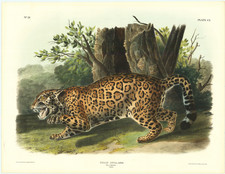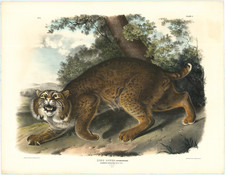Brown Pelican, Pelecanus Fuscus. Male Adult, drawn from nature by John James Audubon and chromolithographed by Julius Bien in New York, in 1860, is a wonderfully composed, true-to-life image of a breeding adult male perched on the branch of a Red Mangrove. This chromolithograph is likely based on a watercolor made by Audubon in the Florida Keys around April or May of 1832.
In the 1830s, the Floridian landscape was a rich tapestry of biodiversity, providing a fertile ground for ornithological studies. Audubon's journeys, as recounted in his writings, took him deep into Florida, where the Brown Pelican, a bird of significant interest, made its home. While the species found sanctuary across the southern shores of the United States, from Cape Hatteras to the far reaches of Florida, by Audubon's time, their numbers had noticeably dwindled, particularly in places like Charleston's inner bay where they were once abundant. Nonetheless, certain areas, like the inlets south of St. Augustine and the Keys of Florida, especially Key West, remained vibrant hubs of pelican activity. Audubon's account conveys a vivid picture of these birds – their habits of fishing, resting on mangroves, and their curious interactions with human settlements.
The Brown Pelican, a distinctive coastal bird recognized by its long bill and a large throat pouch, holds a unique place in the natural history of the United States. Once abundant along the U.S. coasts, its population suffered a dramatic decline in the mid-20th century primarily due to the pesticide DDT. The chemical caused pelicans to lay eggs with thinner shells, leading to large-scale nesting failures. Recognizing the alarming decline, conservationists and government agencies took action. In 1970, the Brown Pelican was listed under the Endangered Species Act. Subsequent efforts, including the banning of DDT in 1972, played a pivotal role in the species' recovery. By 2009, having made a remarkable comeback, the Brown Pelican was officially removed from the list of endangered and threatened wildlife. Today, it stands as a testament to successful conservation efforts, once again dotting U.S. coastlines and serving as an emblem of resilience and revival.
Birds of America: The Bien Edition
The legacy of John James Audubon's Birds of America is one of unbridled passion for ornithology and artistry, a blend of meticulous observation with artistic flair. While the original "Double Elephant Folio" edition is justifiably celebrated for its monumental contribution to ornithology and fine art printing, it is the lesser-known Bien Edition that stands as an equally impressive testament to the evolution of printing technology and the continued appreciation of Audubon’s work.
Julius Bien (1826-1909) was a German-born American lithographer and cartographer, renowned for his significant contributions to American cartography during the 19th century. Born on September 27, 1826, in Naumburg, Germany, Bien originally trained in his homeland, mastering the nascent craft of chromolithography, a method for producing multi-color prints.
In the 1850s, Bien emigrated to the United States, where he set up his own lithography firm, Julius Bien & Co., in New York. His innovative techniques and meticulous attention to detail quickly earned him a reputation as one of the country's leading lithographers. The firm became known for its wide range of work, from maps and atlases to commercial prints and illustrations.
One of Bien's most significant collaborations was with the U.S. government, particularly the U.S. Geological Survey (USGS). In the late 19th century, the USGS undertook the ambitious project of mapping the entire United States. Bien's firm was responsible for producing many of these topographical maps, and he introduced advanced printing techniques that enhanced their clarity, precision, and detail.
However, not all of Bien's ventures were successful. His attempt at reproducing a double elephant folio edition of Audubon's Birds of America in the 1860s, for instance, was left incomplete due to financial challenges posed by the Civil War. Despite this, many of the plates he did produce for this edition are considered masterpieces of chromolithography.
Julius Bien passed away on December 21, 1909, in New York. His contributions to lithography and cartography in the U.S. left a lasting legacy, with many of his techniques becoming standard practice in the field. His maps, in particular, serve as a testament to the evolving understanding and depiction of the American landscape during a period of rapid westward expansion and scientific exploration.
John James Audubon (1785-1851), born Jean-Jacques Rabin in Haiti on April 26, 1785, was a Franco-American ornithologist, naturalist, and painter, celebrated for his detailed illustrations of North American birds in their natural habitats. His major work, a color-plate book titled The Birds of America, is considered one of the finest ornithological works ever produced.
Audubon's early years were shaped by tumultuous events. Born out of wedlock in the French Caribbean colony of Saint-Domingue (now Haiti) to a Creole mother and a French sea captain, he was smuggled to Nantes, France, during a slave rebellion. There, he was adopted by his father and stepmother and raised as their own. His childhood in France was filled with outdoor adventures and initial forays into drawing.
In 1803, to avoid conscription into Napoleon's army, he was sent to America, where he managed one of his father's estates near Philadelphia. This move further kindled his profound interest in the wildlife of the New World. Despite a few failed business ventures and challenges, Audubon remained committed to his passion for nature and art.
His dream to document all of the birds of America began to take form in the 1810s. Travelling through America's wilderness, Audubon observed, hunted, and painted birds. He developed a particular technique that involved wiring freshly killed birds into a natural pose on a board. This innovative method combined with his keen observation allowed him to create more lifelike illustrations than many of his contemporaries.
Failing to secure American subscribers or a publisher for his extensive collection, Audubon traveled to the United Kingdom in 1826. There, The Birds of America was met with critical acclaim. Between 1827 and 1838, this work was published in sections, comprising 435 hand-colored, life-sized prints made from engraved plates.
Audubon followed this success with a companion work, Ornithological Biography, which provided detailed narratives about each species. His later work included studies of American mammals, and he became one of the founding members of the New-York Historical Society.
Despite facing numerous challenges throughout his life, including financial hardships and criticism from some peers, Audubon's dedication to his work resulted in an invaluable contribution to ornithology and American art. He died on January 27, 1851, in New York City. Today, his legacy continues, notably through the National Audubon Society, which promotes conservation and appreciation of birds and their habitats.










![[ Gulf Coast & West Coast of Florida ] De Cust van Westindien Van La Desconoscida, tot C. Escondido. . .](https://storage.googleapis.com/raremaps/img/small/65741.jpg)
![[Florida to New Orleans] The North Coast of the Gulf of Mexico from St. Marks to Galveston . . . 1842](https://storage.googleapis.com/raremaps/img/small/83469.jpg)
![[ Charleston, Boston, New York, St. Augustine, Bahamas, etc ] Particular Draughts of some of the Principal Towns and Harbours belonging to the English French and Spanish in America and the West Indies.](https://storage.googleapis.com/raremaps/img/small/102804.jpg)

![[ Method by which native Floridians discuss matters of grave importance ] Qua ratione Floridenses de seriis rebus deliberant. XXIX.](https://storage.googleapis.com/raremaps/img/small/97363.jpg)